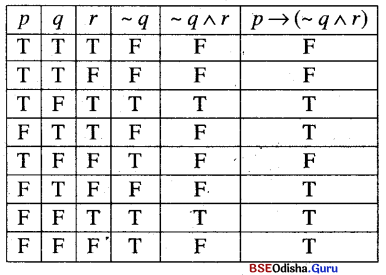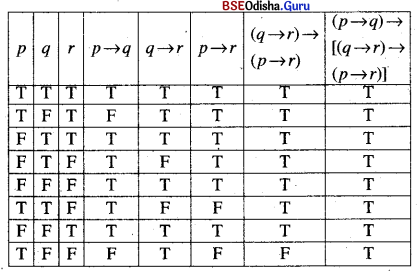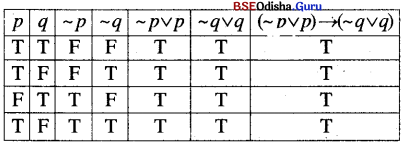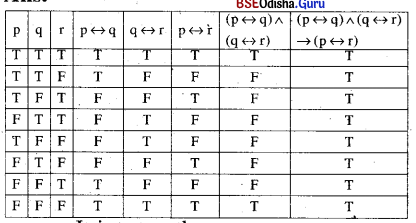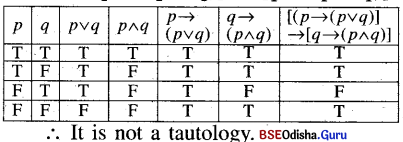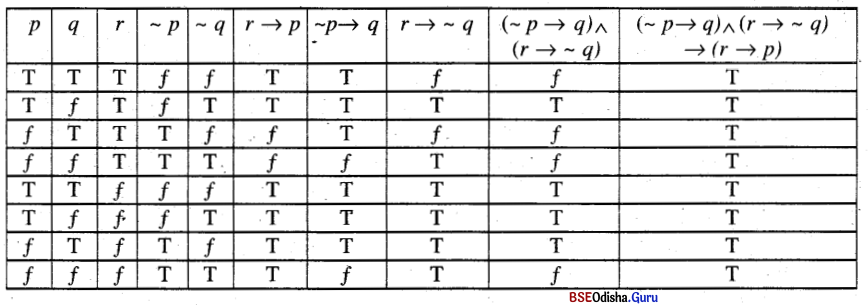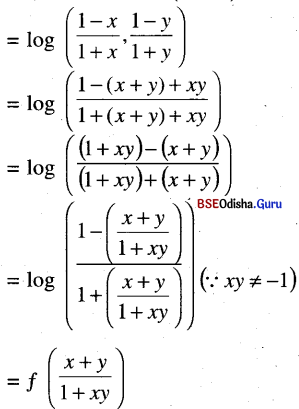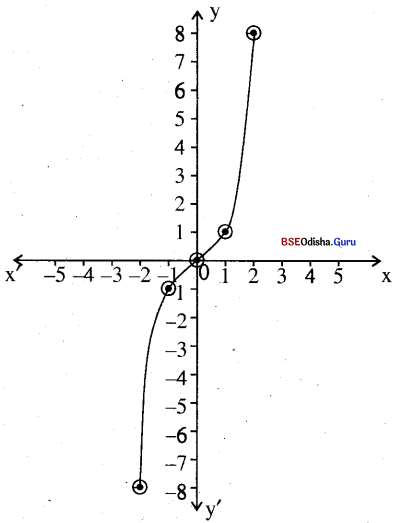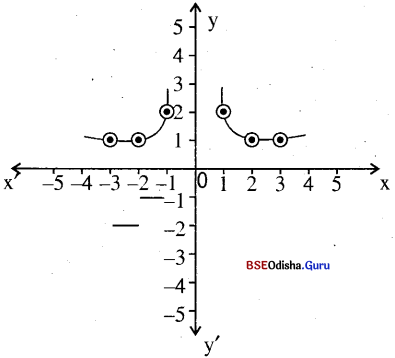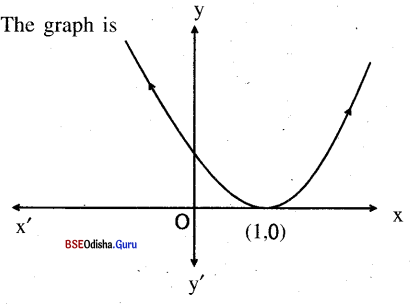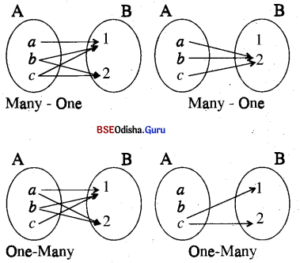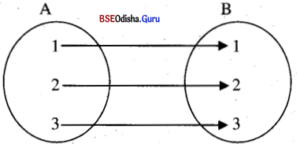Odisha State Board CHSE Odisha Class 11 Political Science Solutions Unit 1 Understanding Political Theory Short Answer Questions.
CHSE Odisha 11th Class Political Science Unit 1 Understanding Political Theory Short Answer Questions
Very Short-Answer Type Questions
Question 1.
What is politics?
Answer:
Politics refers to a social, political process which resolves social issues and maintain social orders. It believes in using power for the promotion of self interest.
Question 2.
What are the objectives of politics?
Answer:
Politics seeks to resolve socio-political conflicts. It tries, to bring order out of disorder and restores social integration.
Question 3.
What is the Marxian view of Politics?
Answer:
According to Marx politics is an instrument of class conflict. The rich and powerful make use of it for their self interest.
Question 4.
What is political science?
Answer:
Political science is a social science which studies about state, government and the constitutional system. It also deals with the origin and development of state and its structure and functions.
Question 5.
What is political philosophy?
Answer:
Political philosophy is the abstract of speculative ideas about any political concept or event. It is value oriented study which seeks to explain the ultimate reality.
Question 6.
What is a political system?
Answer:
Political system is a set of arrangement of political actors and institutions in such a way that policy decisions are easily taken. Modern state is a political system as it adjusts itself to the changing environmental stress.
Question 7.
What do you mean by political dynamics?
Answer:
Political dynamics include those external forces and influences that affect the political process. Political parties pressure groups, interest groups and lobbyists are known as political dynamics.
Question 8.
What is the nature of politics?
Answer:
Politics is involved with the totality of interests in our social life. Politics believes in resolution of conflict and controversy by use of power.
Question 9.
What is political theory?
Answer:
Political theory constitute of those ideas, concepts and principles that influence the constitution, government and social life in a systematic manner. It stands for the history of political ideas and it is based on reality.
Question 10.
What is the need of studying political theory?
Answer:
The study of political theory makes people think rationally about political issues and to assess the political events of our time. It informs us about the basic knowledge of political ideas institutions and concepts that shape our day to day life.

Question 11.
What is the scope of politics?
Answer:
Scope means the subject matter and politics is concerned with the study of state, government, social, political process. Polity making, power structure and administrative process. It also deals with the shaping and sharing of power in society and politics.
Question 12.
What is formal politics?
Answer:
Formal politics refers to the cooperation of a constitutional system of government and publicity defined institutions and procedures. It encompasses the study of political parties, public policy, war and peace, foreign policy etc.
Question 13.
What is informal politices?
Answer:
Informal politics refers to alliance formation, group structure, exercise of power to protect and promote our goals or interests. It is understood as day to day politics that affect our lifestyle.
Question 14.
How politics differs from political science?
Answer:
Political science is the theory whose application is called politics. Political science deals with the origin, nature, working and future of state or a government but politics is concerned with the real issues affecting the system and their solution.
Question 15.
What is state?
Answer:
State is a sovereign political entity. It is the most powerful and universal of all social institutions.
Question 16.
What is Government?
Answer:
Government is the working element of state. It consists of three organs, such as executive, legislature and judiciary.
Question 17.
What is sovereignty?
Answer:
Sovereignty is the most important element of state. It is the supreme and unlimited power of the state over citizens.
Question 18.
Why man is called a social animal?
Answer:
Man is called a social animal because he lives in society and it is society that creates condition for the moral and material development of individual. Man can not live outside society.
Question 19.
What is individualism?
Answer:
Individualism is a political philosophy of 1 9th century. It pleads for maximum liberty to the individual and minimum role to the state. It believes in the economic theory of laissez flare.
Question 20.
What are the functions of a police state?
Answer:
A police state has to defend the state from external aggression. It also maintains law and order and ensures safety and security to the individuals living in the state.

Question 21.
What is modern individualism?
Answer:
Modern individualism is the individualism of19th century. It gives the state of positive role. It raises its voice against excessive state regulation and control.
Question 22.
What is globalization?
Answer:
Globalization is a policy of economic reforms which aims at reducing trade barriers between the developed and developing countries. It seeks the integration of economies through exchange of ideas, information, technology, labour and capital.
Question 23.
What arc the two main goals of Globalization?
Answer:
The two main goals of Globalization are
- To secure the benefits of free trade open access to markets and equal participation in securing sustainable development for all the people, and
- To reduce trade barriers ensuring free flow of capital labour from one Country to the other.
Question 24.
What do you mean by a welfare state?
Answer:
Welfare state is a social service agency which gurantees basic minimum substance to all. It undertakes volumes of social security measures for the poor and backward people.
Question 25.
Why the individualists regard the state as a necessary evil?
Answer:
The state is regarded as a necessary evil because, It interferes in individual liberty and Curtails individual freedom.
Question 26.
What are the two main drawbacks of a welfare state?
Answer:
A welfare state suffers from bureaucratic despotism. It is too much expensive.
Question 27.
What are the two main utilities of Globalization?
Answer:
Globalization accelerates the pace of economic growth. It helps in dissemination of technological knowledge among nations.
Question 28.
Laissez faires
Answer:
The theory of laissez faire is related to individualism. As an economic theory it seeks to give unrestricted freedom to an individual in the economic sphere
Question 29.
Police state
Answer:
Police state concept is developed out of individualism. The individualists consider the state as a police man and argue for giving it only police functions, hence the states is called a police state.
Question 30.
Globalization
Answer:
Globalization is a process of increasing socio-economic industrial and trade relations among the nations all over the world. It seeks to make the whole world a global village. The main trust of globalization is to give the developed nations a free access into the markets of developing nations.

Question 31.
International Recognition
Answer:
International recognition means the recognition of the international society of nations. It is a formal process by which the existing members of the family of nations accord statehood to a newly born state.
Question 32.
External sovereignty
Answer:
External sovereignty means freedom from outside control or influence. By this aspect of sovereignty a state designs its foreign policy.
Question 33.
Internal sovereignty
Answer:
Internal sovereignty is enforced within the territory of a state. It enables the state to make law for the state administration.
Question 34.
Why state is called a necessary evil?
Answer:
Individualists consider the state as a necessary evil. To them state is necessary for maintenance of law and order and to defend it from aggression. It is an end as it interferes with the liberty of individuals.
Question 35.
What are the two major drawbacks of welfare state?
Answer:
In a welfare state the bureaucracy becomes autocratic and oppressive. It is too costly for a poor and backward country.
Question 36.
Utility of globalization?
Answer:
Globalization accelerates the pace of economic growth. It makes exchange of ideas, capital, raw materials, labour and technology between rich and poor countries easier.
Question 37.
Two major defects of globalization
Answer:
Globalization increases industrialization leading to environmental pollution. It increases unemployment and intervens in the autonomy of states.
Question 38.
What is mixed economy?
Answer:
Mixed economy refers to the coexistence of public and private sector for economic development. This type of economy is found in welfare states.
Question 39.
What is New Deal?
Answer:
New “deal refers to a new programmes of action pursued by USA and other western countries to get rid of economic recession. President Franklin D. Roosevelt of USA was the advocate of this reform programme.
Question 40.
What is Beverage Report?
Answer:
Beverage Report was issued in England in 1942 by William Beverage on social insurance. It envisaged a scheme of social security to fight the evils of want, diseases, ignorance, squalor and idleness.
Question 41.
Negative functions of welfare state
Answer:
A welfare state gives protection against unemployment, poverty and disease. It fights against natural calamities and safeguards children, women and weaker sections of society.
Question 42.
Positive functions of welfare state
Answer:
A welfare state provides the people a wide range of health service and education to the people. It generates employment opportunity and provides social security to old aged and economically disadvantaged sections of society.

Question 43.
What is modern individualism?
Answer:
Modern individualism is 20th century individualism. It regards the state as a positive and useful institution.
Question 44.
What for state is necessary?
Answer:
State exists for the sake of good life of individuals. It maintains order and helps the individual in realization of his potential.
Question 45.
Theoretical Politics and Applied Politics.
Answer:
Scholars like, Sir Frederich Pollock, Jellinek and Willoughby have distinguished between theoretical and applied politics. Theoretical politics deals with the theory of state, but applied politics deal with structure and working of state. The artificial politics deals with law and administration of state but applied politics with the application of law. Theoretical politics is a science but applied politics is an art.
Question 46.
Politics and Political science
Answer:
The two terms ‘Politics’ and ‘Political Science’ are often used interchangeable, but they differ on the following grounds.
- Politics is the practical aspect of Political science
- Political science is the theory which in practice is known as politics.
- Political science is normative but politics deals with operational aspect.
- Political science is an academic discipline and its principles are universal, but politics differs from state to state.
- Politics is an art, but political science is a science,
- The term politics is much broader a concept than that of political science. In the modern age politics is concerned with the study of conflict and cooperation is society with the help of power.
Question 47.
Political science and Political Philosophy
Answer:
Political science differs from political philosophy on the following ways.
Political science is a science of state and government but political philosophy is a science political values and beliefs. Political science is more empirical than normative, but political philosophy is theory oriented. Political science is more concerned with what is and what ought to be but political philosophy prescribes what is good, just and proper. Political science seeks to analyze political phenomena to frame general laws but, political philosophy is value oriented and normative. Political philosophy is a part and parcel of Political science.
Question 48.
State and Government
Answer:
State is a sovereign political entity, but government is an element of state and it fulfills the purpose of state. State is sovereign, but, government exercises sovereign power. State is permanent but government is temporary. State has a definite territory and population but government consists of a few senior citizens and it works within the state. State is abstract but government is concrete. Membership of state is compulsory but not of government.
Question 49.
Individualism and socialism
Answer:
- Under individualism individual is the centre of society but under socialism state is central. Individualism pleads for maximum liberty to the individual but socialism pleads for maximum power to the state. Individualism regards the state as a necessary evil, but socialism holds the state a positive good.
- Individualism gives the state only police functions but socialism gives the state both social economic political and welfare functions. Individualism regards the state as a means, but socialism regards it as an end. Individualism pleads for private property but socialism opposes it.
Question 50.
Traditional and modern individualism
Answer:
Traditional individualism was a philosophy of 17th to 19th century, but modern individualism was a philosophy of 20th century. Traditional individualism was exported by Adamsmith, Herebet Spencer and J.S. Mill, but modern individualism was exposed by Laski, M.P. Follett and Norman Angell.
Traditional individualism regards the state as a necessary evil, but modern individualism regards the state, as a useful institution. Traditional individualism regards the state as a perpetrator of individual liberty, but modern individualism regards it as a coordinator, a facilitator. Traditional individualism insists on individual identity and progress but modern individualism on group identity of individuals. Traditional individualism accords police functions to the state but modern individualism accords welfare functions to the state.
Question 51.
Globalization and internationalism
Answer:
Internationalism stands for increasing cooperation and peaceful co-existence among nations. But, globalization is a process of economic integration of the whole world. Internationalism pleads for avoidance of war and restoration of peace, But, globalization seeks to increase economic and trade relations among nations. Globalization seeks to secure the socio-economic integration and development of all people, but internationalism stands for safety and cooperation of nations. Globalization is an aspect of internationalism.
Question 52.
State and Civil policy
Answer:
State is a sovereign political unit, but civil society is a non governmental voluntary movement for the sake of people. State is sovereign but civil society is not sovereign. State enjoys coercive authority but civil society does not. Civil society exists within the state. State has a territory and population, but civil society has no definite territory nor any fixed population. State can be autocratic but civil society can’t.
Short Questions With Answers
Question 1.
What is political Science?
Answer:
Political science is a social science deals with the study of state and government. It investigates about the origin and evolution of state, the nature and working of political institutions, processes and principles of conduct. It also analyses about the power structure. It is a science of society and civilization. It is the study of political behaviour and political systems In the modern age it studies about the environment.
Question 2.
Nature of Political Science
Answer:
Political science is a social science. Political science comes closer to a science as it follows scientific method of study. It is an art as it applies the knowledge of science for state administration. It has no agreed principles. It is unpredictable andIts decisions are inexact.

Question 3.
Political Science is a science
Answer:
Political science is considered to be a subject of science because It believes in scientific method. There is systematic study undertaken on the subject. It studies about individual behaviour, institutions and processes It undertakes experimentation and observation of facts; and To a great extent its decisions are exact. So it may not be a science like physics or chemistry but a science like meteorology or astronomy which can’t make accurate predictions.
Question 4.
Scope of Political Science
Answer:
The scope of political science is vast and expending. It covers the study of state government and legal system. It involves the study of various political systems. Political science also deals with political ideas and ideologies. It encompasses the study, of political parties, pressure groups and other non political institutions. It studies about local and municipal bodies, elections, voting behaviour, inter state relations and about war and peace.
Question 5.
Political science begins and ends with state
Answer:
This statement of Gamer confines the study of political science to state. State is the be all and end all of political science. It investigates about the origin and evolution of state nature of state and working of different states. It also deals with the manifestation and development of state. It covers the study of past, present and future of state.
Question 6.
Political Science is a power science
Answer:
Lasswell and Kaplan along with other modern scholars regard political science as a power science. It deals with power relationship of states. Power is the fundamental principles of every conflict and the ultimate means to any solution. Political science seeks to explain the modes of acquisition of power, exercise of power and sharing of power with others.
Question 7.
Political science is an art
Answer:
Political science is by nature an art, because It applies the knowledge of science in day to day political process. The knowledge of political science is essential for politicians, leaders, diplomats, bureaucrats and for a common man. The knowledge of political science is necessary for begin success in real politics. If not only broadens our knowledge but also helps in the development of state.
Question 8.
Significance of Political Science
Answer:
The knowledge of political science is essential for every individual to know about the state government and other political institutions. It broadens our knowledge of politics to understand the complexities of modern state. It promotes political consciousness and awakens people about their rights and duties. It increases the rate of political participation. Political science teaches us about cooperation, tolerance and national integration. It creates ideal citizens.
Question 9.
Political Science is not a science
Answer:
Political science is not a science because, There is no agreement among scholars as to its meaning methods of study, principles and conclusions. Its principles are not universally valid. It studies human behaviour which is unpredictable. It can’t make objective study of political phenomena. Fully scientific method of investigation is impossible in political science. Its predictions are not exact.
Question 10.
Political Science and Philosophy
Answer:
Political science and Philosophy go hand in hand. Political science is a part and parcel of Philosophy. Philosophy is based on certain ideal doctrines and values which the political leaders and policymakers should practice. Philosophy is a science of knowledge and wisdom which make political thinkers and leaders think about the betterment of society. Both Political science and Philosophy cover some common ground, and both seek to promote good life of the citizens. The laws and policies of the government should be philosophically-sound.
Question 11.
Elements of State
Answer:
State is a sovereign political with four basic elements. Population is essential for a state, because it is a community of persons.State is a territorial unit and without a definite territory no state can exist. Government is the most vital element of state which enacts and enforces laws. Sovereignty is the most essential attribute of state which distinguishes it from other organizations. All these elements vest a state with real statehood.
Question 12.
Why the State is necessary? Or Need of the State
Answer:
State is a natural institution which protects the people and tries to ensure conditions for their happiness prosperity and development. It protects the people from internal disorder and external threat. It regulates economy and formulate and implements all financial policies for the well being of citizens. It undertakes steps for the socio economic, political and cultural development of the people. It ensures safety and security to the life liberty and property ofthe citizens. State creates a moral political order where citizens grow and prosper.

Question 13.
State is superior to all associations
Answer:
As a sovereign political unit state is considered superior to all other associations. It regulates and controls the activities of all other organizations. All associations exist and work on the basis of the laws of the state. State has the power to Compel all other associations to do as the state demands.
Question 14.
What is Government?
Answer:
Government is an element of state. It is the political organization of the state. The state has no life but the govt gives life to the state. The state acts through the government. The government fulfills the mission of the state. It may come and go but it gives life to the state.
Question 15.
What is sovereignty?
Answer:
Sovereignty is the supreme power of the state over citizens. Using this power the state enacts laws and runs the administration. It resides only with the state and no other association or organization enjoy it. Sovereignty can be internal or external. Internal sovereignty is exercised upon citizens, nationals and organizations. External sovereignty makes the state take final decisions in the outside world.
Question 16.
Internal and External Sovereignty
Answer:
Sovereignty has two aspects, internal and eternal. Internal sovereignty is exercised within the territorial limits of state. But external sovereignty, is exercised in the international sphere. By means of internal sovereignty the state makes law, but by external sovereignty if formulated foreign policy. It is for internal sovereignty people pay allegiance to state, and for external sovereignty no other state can dictate terms to the other. Due to internal sovereignty no other association or organization can disobey the state. But, due to external sovereignty no foreign state can interfere in the internal affairs of state.
Question 17.
What is a political system?
Answer:
The term political system corresponds to the word state. It includes the working elements of state along with other political forces that influence the state. A political system is a set of inter relationship through which policy decisions are made. It is concerned with power, rule and authority. It includes all governmental and non-governmental organizations, caste groups political parties, pressure groups and the people. Executive, Legislature and Judiciary are the working units of political system.
Question 18.
International Recognition
Answer:
International recognition means the acceptance by the family of nations. It is a formal process of according statehood to a newly born state. It gives a formal recognition to a state to be involved in relationship with other state. It is not an indispensable condition of statehood because, a state can exist even without international recognition. But, it is required for active participation in the field of international cooperation. It is supporting element of state.
Question 19.
State is a called an association of associations
Answer:
State is sovereign political association There are many more associations within the state. As a sovereign and powerful association it coordinates, controls and regulates the activities of other associations. All other associations are subordinated to the sovereign power of the state State is therefore, called an association of associations.
Question 20.
What are the factors responsible for the rise of modern individualism?
Answer:
The factors responsible for the rise of modern individualism are given below The complexities of modern society. The discontentment that developed after the world war. Loss of faith upon parliamentary democracy. Increasing role of bureaucracy. Inability of the individual to face the challenges of modern society.
Question 21.
What are the hindrances before the welfare state?
Answer:
The hindrances faced by a welfare state are Scarcity of production Rapid growth of population Fear of high taxation Increasing corruption Development of narrow loyalties and Environment pollution
Question 22.
What is individualism?
Answer:
Individualism is a political doctrine which grants maximum liberty to the individual against state interference It protects the rights of individuals. Under the system, the state performs only negative functions regulating the activities of individuals. Individualism pleads for free market economy. As a socio political theory it is based on the value of human personality. It believes in the laissez faire theory.

Question 23.
What are the merits of Individualism?
Answer:
Individualism grants maximum liberty to the individual for his self development. It gives economic freedom to the individual to maximize profit. It gives more opportunity to the talented ones. It helps in increasing production ensuring economic progress. This theory creates condition for the survival of the strong and efficient persons. It expresses full faith upon individual ability and character and therefore grants maximum freedom to the individual to mobilize his resources for himself and society.
Question 24.
What are the demerits on Individualism?
Answer:
State is a welfare agency but the individualists regard it as an evil which is wrong. Individualism considers the individual as the best judge, but actually, individual is swayed by emotion and passion. Individualism wrongly holds that individual and society are antithetic. But in practice individual good and social welfare are not contradictory. Individualism pleads for free competition which will result in the exploitation of the poor by the rich, wastage and unemployment. Its biological argument of survival of the fittest is in human.
Question 25.
What are the functions of an individualist state?
Answer:
The individualists give the state only negative functions such as Protection of the individual against external enemies. Maintenance of law and order within the state. And the enforcement of contracts lawfully made. The state protects the life, liberty and property of individuals and safeguards against them from personal injury and slander.
Question 26.
What is modern individualism?
Answer:
The individualism of the 20th century is called modern individualism of the 20th century is called modern individualism. It believes in the increasing role and functions of the state but protects against excessive state regulation and control. Instead of autonomy of individuals, it gives the groups a separate identity. Modern individualists give the state role of a coordination agency.
Question 27.
Why the individualists consider the state as a necessary evil? Or, State is a necessary evil why?
Answer:
The individualists look upon the state as a necessary evil because of the following reasons. The state is necessary for regulating the activities of selfish and egoistic individuals. It must protect the individual from personal harm, injury and slander. It is an evil, as it interferes in individual liberty and curtails individual freedom. It curtails general interest for individual interest.
Question 28.
What is the meaning of a welfare state?
Answer:
Welfare state is a 20th century phenomenon which is the product a compromise between communism and individualism. It guarantees a minimum standard of subsistence without removing incentives to private enterprise. It is a social service agency which undertakes developmental activities relating to social welfare and security. It puts equal emphasis on the individual and society. It regulates national economy through planning.
Question 29.
Write down the features of welfare state.
Answer:
A welfare state is a social service agency which ensures common good. It always seeks to promote people’s welfare. It is a compromise between extremes of individualism and socialism. It believes in democratic procedure principles. It regulates national economy through planning. The state protects the rights of all equally without discrimination. It guarantees the basic minimum needs to every individual.
Question 30.
What are the demerits of Welfare state?
Answer:
Welfare state is an expensive system for which a huge amount of funds are required. It leads to bureaucratic despotism. It magnifies the state at the expenses of respect for the individual. As the state undertakes all types of activities the role of voluntary associations decline.
Question 31.
What are the obligatory functions of a state?
Answer:
To protect the life, liberty and property of the people. To maintain law and order, peace and security. To protect the country from external attack. To administer free and fair justice to all
Question 32.
What are the voluntary functions of a state?
Answer:
The state provides medical help and hygienic conditions to the people. It seeks to spread education all over the countries. The state regulates trade, industry and development of agriculture. It provides for a variety of social security functions such as insurance old age pension, employment generation and sickness and physically disabled allowance etc. The state regulates public utility services like transport, electricity, postal, and air services.

Question 33.
What are the political functions of a Welfare State?
Answer:
A welfare state performs the following political functions It safeguards individual rights. It maintains free, fair and periodic elections. It makes provision for the participation of the masses in public affairs. It coordinates the interests and activities of various groups, associations and parties. It eradicates corruption, nepotism and dishonesty. It generates political awareness.
Question 34.
What is the meaning of Globalization?
Answer:
Globalization is the name for the integration of economics through exchange of ideas, information, technologies, goods, and services. It is a policy of economic reforms which aims at reducing trade barriers between the developed and developing countries. It believes in the integration of nation states within the framework of WTO.
Question 35.
What are the objectives of Globalisation?
Answer:
The objectives of globalization are Socio-economic integration of the whole world. Interesting industrial trade cultural relations among the people all over the world. Securing the benefits of free trade, open access to markets and equal participation in securing sustainable development for all the people. Reduction of trade barriers, to ensure free flow of capital and labour from one country to the other. Exchange of goods and services.
Question 36.
What are the features of Globalization?
Answer:
Globalization stands for liberalization of economy. It stands for free flow of trade relations. Globalization of economic activity. Liberalization of import export system. Privatization of means of production and distribution. Economic reforms and increasing collaborations among nations.
Question 37.
What are the social functions of welfare state?
Answer:
The social functions of welfare state are Establishment of social equality among people. Securing social justice. To make provision for social security and welfare of the poor and backward people. Fighting social evils. Rendering social utility services. Spread of education and protection of public health etc.
Question 38.
What are the economic functions of Welfare state?
Answer:
The economic functions undertaken by a welfare state are Improvement in the economic condition of the people. To draw plans for balanced economic development. Development of agriculture and industry Regulation of trade and commerce. Etc
Question 39.
What a modern state can’t do?
Answer:
A modern welfare state can’t interfere in the following spheres of individual. It can’t curtail religious freedom of the people. It can’t suppress public opinion It can’t interfere in the social customs and fashions of the people. It can’t interfere in personal life of the people, and It can’t interfere in cultural and literacy matters of the people.
Question 40.
What role does the state play in an era of Globalization?
Answer:
The role of modern state has changed in an era of globalization. The state continues to be a Welfare State. It acts as a facilitator and co-ordinator economy and it tries to secure stability in the market through macro economic policies. It provides social services like education health and other welfare activities.
Question 41.
What are the evil impacts of globalization?
Answer:
Globalization gives more importance to corporate business capitalists and multi national corporations. It helps the developed nations to control the world economy. It creates difficulty for the developing countries to complete with developed countries. It leads to increase in the gap between rich and poor. Small and medium range industries will suffer a loss. It will lead to neglect of working class.
Question 42.
What are the merits of globalization.
Answer:
Globalization has accelerated the pace of economic integration of the world. It strengthens international peace and stability. It is the best possible means to secure sustainable development of the world. It enhances socio-economic linkages among nations. It helps in dissemination of technical know how among nations. It seeks to encourage interdependence among nations.

Question 43.
What are the impacts of globalization on Indian Economy?
Answer:
Globalization in India has given rise to export of goods. There are greater flow of foreign investment. Increase in GDP. Neglect of poverty eradication programme. There is sharp decline in employment growth. It resulted in a set back to industry and agriculture.
Question 44.
Good effect of globalization
Answer:
The good effects of globalization on Indian economy are Increase in export of Indian goods and services. Increase in foreign investment coming to India. Consistency in GDP growth. Sharp rise in communication and healthy social order. It is a necessity of modern times.
Question 45
Evil impacts of Globalization and developed nations are exploiting the underdeveloped nations.
Answer:
As a result of globalization the rich and developed nations are exploiting the underdeveloped nations. The foreign countries have entered into Indian markets. The poor people are facing poverty and exploitation. Unemployment has risen. It has badly affected Indian Industry and agriculture. It has given rise to global economic recession.
Question 46.
Nature of politics
Answer:
Politics is concerned with the day to day organized political activities in society. It seeks to resolve the conflicts and controversies arising between two groups or individuals. Power is the be all and end all of politics. Politics is the process of realization of interests or goals by using power. It is found every where in society. In family political parties, religious institutions educational institutions and in all human association. From the point of view of science or art it is by nature an art.
Question 47.
Liberal view of politics
Answer:
The liberals define politics taking the relationship of individual and society into account. Individual is the centre of politics. In society individuals and groups fight with each other for their goals and politics seeks to resolve these conflicts. It brings order out of disorder and promotes the social well being. Politics seeks to bring unity, peace and stability in society.
Question 48.
Marxian view of politics
Answer:
Marxists rejects the liberal view of politics and state that politics results in class struggle. It creates division between rich and poor educated and uneducated and various social grounds. The rich make use of politics to exploit the poor.
Question 49.
Politics is a struggle for power
Answer:
The modern scholars like, Lasswell, Robert Dahl etc. regard politics as a struggle for power. The ongoing conflict between individuals & groups in society for accumulation and use of power is known as politics Politics gives top priority to power & It is concerned with the political process.
Question 50.
What is the scope of politics?
Answer:
Scope implies the subject matter of study of politics and it includes The study of state government, society, socio-political system, policy making etc. The study of conflict, rivatry between individuals and groups. The study of shaping and sharing of power. The study of political process, election, government formation, eradication of poverty corruption, illiteracy, legislation and adjudication etc. Politics also studies about local government, public administration, international policies, war and peace, united nations, foreign policy and relations of national interest.
Question 51.
What is political theory?
Answer:
Political theory refers to the empirical study of political concepts events and issues. It comprises of philosophy, psychology, economics and history within itself. It is factual and based on reality. Political theory is moral reasonable and universal in character. Any systematic statement of political thinkers on any political social issue or event is called political theory.
Question 52.
The usefulness of studying political theory: Or, Significance of studying political theory.
Answer:
The study of political theory is necessary for the study of political events. Issues and conflicts and for their solution. By study of political theory we derive knowledge about political ideals, ideologies and institutions. It also deals with the behaviour of individuals and institutions. It gives us a clear picture of political issues and events where by valid decisions can be made. Political theorem provides stability to the political system and influences politics and society.

Question 53.
What is modern political theory?
Answer:
Modern political theory refers to the theoretical development in the post world war era. It is scientific in nature and based on reality. It believes in modern techniques like, observation, data collection, analysis objective study of politics and empirical study. It is inter disciplinary in character. Modern political theory seeks to make political research based on facts and evidence so that reasonable decisions can be made.
Question 54.
What is classical political theory?
Answer:
Classical political theory is value oriented and moral in character. The uniting of scholars like, Plato, Aristotle, Machiavelli, Hobbes, Hegel, Rousseau, etc. are all classical in character. It gives priority to ethical politics. It seeks to strike a balance between individual liberty and state control individual state relationship & goals of the state.
Question 55.
Elements of politics
Answer:
Politics is the behavioural dimension of political science. Realisation of interest, conflict over interest and using power for realization of interests are the three basic elements of politics In society people fight for their self interest and whenever they use power and influence for the purpose it is called politics. When power is used for socio political and economic purpose it is called politics.
Question 56.
Evolution of Individualism
Answer:
Individualism developed as a practical theory during 19th century. It emerged from the mercantile individualism of18th and 19th century in Britain, France and Germany. The industrial revolution in Britain in 18th century gave rise to free economic competition and gradually individualism emerged. The French physiocrats were the initial exponents of individualism but it was Adamsmith who gave it the shape of a political theory. Besides Smith, Hobbes, J.S. Mill, Spencer, Hayek, Milton, Nozik, etc. developed it into a full fledged philosophy.
Question 57.
Individual is not the best judge
Answer:
According to individualists indivual is the best judge of his ability, power and self interest. But, it is not always correct state is more matured and capable to judge the self interest of individual. Individual is emotional and he may commit any mistake out of emotion but state is conscious and all actions of state are based on reason and free from passion. The state uses its resources for the well being of individuals.
Question 58.
Individual and state are complementary.
Answer:
Individualism find antipathy between individual interest and states interest but actually, the interests of the state and individual is complementary. State has no interests of its own. Its interest is the sum of individual interest. State resolves all conflicts arising among individuals. The state promotes the interests, security and progress of every individual.
Question 59.
What does survival of the fittest mean?
Answer:
Individualism believes in the principle of survival of the fittest. It means that every time there is a competition among individuals and those who are capable, talented and efficient only survive and the rest perish. There is no scope for the weak, indolent and ignorant people in a state. Charles Darwin and Herbert Spencer were the protagonists of this view. It is scientific and justified also
Question 60.
Laissez fair
Answer:
Laissez fair is a French word which means, let the individual free to take economic or financial decisions. From economic point of view, every individual is conscious of his self interest best. When the individual works for his profit he works with all sincerity and commitment. For the development of agriculture industry and business the individual must be given full freedom.
Question 61.
Features of modern individualism
Answer:
Modern individualism is the 20th century individualism. It gives priority to groups than individuals and recognizes the positive role of state. Graham Walls, Normal Angel, Miss Folel were modern individualists. Modern individualism gives more importance to social welfare than individual good. It pleads that the state can eradicate the obstacles facing individuals.
Question 62.
What is New Deal programme?
Answer:
New Deal was the brain child of former US president F.D. Roosevelt. It was a programme for reform which made the state interfere in the economic sphere creating opportunities for employment and ensure greater social security. During the great economic recession in USA in 1930s, President Roosevelt initiated these reforms to enhance the financial condition of individuals. It generated employment opportunities and provided assistance to the diseased, physically challenged and poor people. This new deal plan created condition for a welfare state.

Question 63.
Beverage Report
Answer:
When during the second world war there was world wide recession thousands of people become homeless, unemployed underfed and discussed. In the mean time, William Beverage, a Brithsh national, provided a report in 1942 for introduction of social insurance and national health mission to save the people. As per the report the state shall provide basic minimum health service, insurance and opportunities for income to all. This beverage report led to nationalization of Banks, railways, mines, steel and means of transport etc. It laid the foundation of welfare state.
Question 64.
India is a welfare state.
Answer:
Indian constitution, under Act 38 envisages the goal of a welfare state. The government of India provides basic minimum needs to every individual. Act 39 provides right to work and the right to a decent wage. The state through abolition of poverty, unemployment health service, insurance, social security and spread of education seeks to realize the goal of welfare state. The state also looks after the protection and security of women, children and backward classes.
Question 65.
What were the factors responsible for the evolution of modern Individualism?
Answer:
The following factors led to the evolution of modern Individualism. Problem ridden modern society Public displeasure over the first world war Distruct of parliamentary democracy. Growing importance of Bureaucracy. And the helplessness of the people to face these challenges led to the emergence of modern individualism
Question 66.
Challenges to welfare state
Answer:
The following factors pase a threat to welfare state today Scarcity of production of goods and food grains Population explosion. Increase in rate of taxes. Environmental pollution and Narrow-mindedness of the people
Question 67.
What are the positive impacts of globalization on Indian economy?
Answer:
Globalisation has strengthened Indian economy in the following manner, It has led to the growing demand for Indian goods and services all over the world. Foreign direct investment has increased. Domestic production has increased. There is spread of transport and communication, information and technology. There is growing awareness about human rights and environmental safety.
![]()
![]()
![]()
![]()
![]()
![]()
![]()
![]()
![]()
![]()
![]()
![]()
![]()
![]()
![]()



